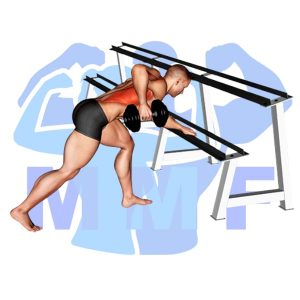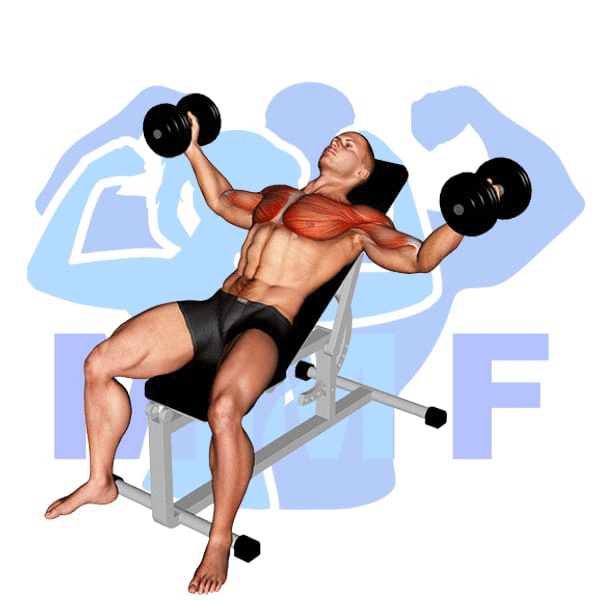Do you find it challenging to isolate and train your rear shoulder muscles? Are you struggling to build a V-tapered physique or improve your posture? You’re not alone! Many people face this issue even after completing exercises like overhead presses and lateral raises. The cause? Neglecting to incorporate dumbbell rear deltoid raises into their workout routine. But don’t worry, we’ve got you covered! In this post, we’ll guide you through the most effective ways to perform this exercise and offer tips for getting the best results. With a little patience and dedication, you’ll be well on your way to achieving that powerful and defined back you’ve always wanted!
Dumbbell Rear Deltoid Raise Summary
- Primary Muscles: Deltoid – Posterior
- Secondary Muscles: Brachialis, Brachioradialis, Infraspinatus, Latissimus Dorsi, Rhomboids, Teres Minor, Trapezius – Lower, and Trapezius – Middle
- Equipment: Dumbbell and Bench
- Mechanics Type: Compound
- Force: Pull
- Utility: Basic

Dumbbell Rear Deltoid Raise Instructions
- You may get started by taking up a dumbbell and positioning one leg and on hand on a flat bench, support yourself with the other foot on the floor.
- Now, pick up the dumbbell with your not support hand, ensure the dumbbell is rotate so that your palm is facing your foot.
- Next, pull the dumbbell up using your rear deltoid, your elbow should be pointing out to the side.
- After you have achieved your maximum range of motion, lower the dumbbell back down until your arm is extended.
- Repeat until you have completed your needed reps on one side, then switch sides to complete a full set with both arms.
Video Tutorial
Dumbbell Rear Deltoid Raise Muscles
Target (Agonist)
Synergists
- Brachialis
- Brachioradialis
- Infraspinatus
- Latissimus Dorsi
- Rhomboids
- Teres Minor
- Trapezius – Lower
- Trapezius – Middle
- Wrist Flexors
Dynamic Stabilizers
Stabilizers
Antagonist Stabilizers

Benefits of Dumbbell Rear Deltoid Raise
The Dumbbell Rear Deltoid Raise is an effective exercise for targeting the posterior deltoid muscle. This exercise strengthens the back of the shoulder and provides stability to the shoulder joint. It also helps build a stronger and more defined shoulder, giving the appearance of a broader and more muscular back. Additionally, this exercise helps improve posture by strengthening the muscles of the upper back and reducing the risk of injury. The Dumbbell Rear Deltoid Raise is a great addition to any strength training or fitness routine and can help you achieve a stronger and more toned physique.
Tips for Performing Dumbbell Rear Deltoid Raise
If you’d like to experience the greatest results, you must stick to these easily done tips. Similarly, when you want to protect yourself against an injury, you should implement these tips.
- Use the weight that enables for a complete contraction and extension.
- Make certain you have warmed up your muscles before you begin your lift.
- Breathe In When You Stretch Your Muscle Tissues And Exhale While You Contract Your Muscular Tissues.
- Consume Water. You will have a great deal more energy and recover faster when you consume water while exercising.
Benefits and Tips Video
Frequent Mistakes To Avoid
You want to refrain from these typical errors to keep superb technique and continue to develop gains. Additionally, when you stay away from these issues you will reduce the odds of having injuries.
- You Don’t Want To Trai Alone. Your workout buddy might be an amazing motivator. A workout partner can certainly be valuable spotter.
- Avoid Using To Little or Too Much Resistance. Not enough, and you will not be effecting your main muscles, excessive, and it will lead to cheating. Ensure you concentrate on your proper movement.
- Don’t Relax Your Abs. Maintaining your core tight to protect your spinal column by maintaining your internal pressure.
Find More Dumbbell Exercises Here
Variations and Complementary Exercises
When performing the Dumbbell Rear Deltoid Raise, it’s important to use proper form and technique to get the most out of the exercise and reduce your risk of injury. If you’re looking to switch up your routine, here are some variations, complementary, or alternative exercises that work similar muscles as the Dumbbell Rear Deltoid Raise.
Dumbbell Supported One Arm Row

The Dumbbell Supported One Arm Row is an excellent complementary exercise to the Dumbbell Rear Deltoid Raise. It targets the posterior deltoid, as well as the rhomboids and middle trapezius, which are all muscles used during the Dumbbell Rear Deltoid Raise. It also helps strengthen the lower back and improves posture. The exercise can be done using a bench or a stability ball, making it a great alternative to the Dumbbell Rear Deltoid Raise. To perform the exercise, place one hand on a bench or stability ball and row the dumbbell up towards your chest while keeping your back flat. This is a great exercise to improve shoulder strength and stability.
Inverted Rows

Inverted Rows, also known as Bent Over Rows, are a great complementary or alternative exercise for Dumbbell Rear Deltoid Raises. This exercise works the back muscles by having you hang from a bar, with your arms straight down and your feet on the ground. From this position, you pull your body up toward the bar while squeezing your shoulder blades together. This exercise targets the muscles of the back, including the rear deltoids. It is a great way to strengthen and build these muscles, while also improving posture and balance. Additionally, it can be done with lighter weights, making it an ideal exercise for those who are just beginning to build strength.
Reverse Fly With Bands

Reverse Fly With Bands is a great complementary or alternative exercise to the Dumbbell Rear Deltoid Raise. It targets the rear deltoids, as well as other muscles in the shoulder, including the rotator cuff muscles. Unlike the Dumbbell Rear Deltoid Raise, Reverse Fly With Bands involves the entire range of motion in the shoulder joint. It also requires you to stabilise your body and use your core to keep good posture. The bands provide additional resistance, making it a great way to challenge your muscles and build strength.
Check Out These Top Dumbbell Exercises
Seated V Bar Cable Row

The Seated V Bar Cable Row is a great complement to the Dumbbell Rear Deltoid Raise as it works the same muscles in the back, but from a different angle. This exercise is completed by sitting on a bench and grabbing the V Bar with both hands. Keeping your back straight and your core engaged, you then pull the bar towards your chest and squeeze your shoulder blades together. This exercise targets the upper back, lats, and rear deltoids—all of which are also worked in the Dumbbell Rear Deltoid Raise. The Seated V Bar Cable Row is a great alternative exercise to incorporate into your routine to keep your back muscles engaged and help build a strong and healthy body.
Cable Crossover Reverse Flys

Cable Crossover Reverse Flys are an excellent complementary or alternative exercise to Dumbbell Rear Deltoid Raises. This exercise targets the posterior deltoids in the same way, but with the added benefit of providing resistance throughout the entire range of motion. It also involves a greater range of motion, allowing for a greater stretch on the muscles. Additionally, the cables provide a smooth and consistent resistance, which can help to prevent injury and make for a more effective workout. This exercise is a great way to increase shoulder strength and stability.
Dumbbell Bent Over Row

The Dumbbell Bent Over Row is an excellent complementary or alternative exercise for the Dumbbell Rear Deltoid Raise. It involves hinging forward from the hips with a flat back and keeping the core tight, while holding two dumbbells in each hand. The arms are then pulled up towards the chest in a rowing motion, squeezing the shoulder blades together at the top of the movement. This exercise is great for strengthening the muscles in the back, shoulders, and arms, which are used in the Dumbbell Rear Deltoid Raise. It can also be used as an alternative to the Dumbbell Rear Deltoid Raise when targeting specific muscles in the shoulders and upper back.
Find More Back Exercises Here
Opposing Complementary Exercises
To further enhance your shoulder workout, it is important to incorporate exercises that target opposing muscle groups. This helps to keep your body balanced and prevents injury. Below are a few exercises that you can add to your routine to work the opposite muscles of the Dumbbell Rear Deltoid Raise.
Barbell Bench Press

The Barbell Bench Press is a great complementary exercise to the Dumbbell Rear Deltoid Raise, as it works the opposing muscle group. This exercise strengthens the chest muscles, which are important for pushing movements, while the Dumbbell Rear Deltoid Raise strengthens the back muscles, which are important for pulling movements. This combination of exercises helps to create a balanced and strong physique, as well as improving overall fitness.
Barbell Reverse Grip Decline Bench Press

The Barbell Reverse Grip Decline Bench Press is a great exercise to complement the Dumbbell Rear Deltoid Raise as it works the opposing muscle group. This exercise targets the chest, specifically the lower portion of the chest, while the Dumbbell Rear Deltoid Raise works the back of the shoulder. The Barbell Reverse Grip Decline Bench Press works the chest muscles in an incline motion, while the Dumbbell Rear Deltoid Raise works the back of the shoulder muscles in a downward motion. By performing both of these exercises together, you can create a balanced workout that will help build strength and improve posture.
Decline Dumbbell Bench Press

The Decline Dumbbell Bench Press is a great exercise for strengthening the chest muscles and is complementary to the Dumbbell Rear Deltoid Raise. This exercise targets the pectoral muscles, which are the opposing muscle group to the rear deltoids. The Decline Dumbbell Bench Press helps to build strength and size in the chest muscles, while the Dumbbell Rear Deltoid Raise helps to build strength and size in the rear deltoid muscles. Together, these two exercises can help to develop an overall balanced physique.
Get Bolder Shoulders with Dumbbell Rear Deltoid Raises
Looking to get bolder shoulders? Dumbbell rear deltoid raises can help you achieve that goal. Focusing on the posterior deltoids, these raises target the muscles responsible for shoulder extension, which can improve posture and improve overall shoulder strength. Start with a light-weight dumbbell and work on perfecting your form before moving on to heavier weights. Remember to keep your shoulders down, engage your core, and take breaks as needed to avoid injury. Incorporating these raises into your fitness routine can help you achieve the shoulders you’ve been working towards.
References: Wikipedia | ExRx.net | PubMed.gov | Comprehensive List of Back Dumbbell Exercises




